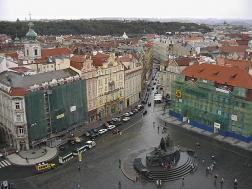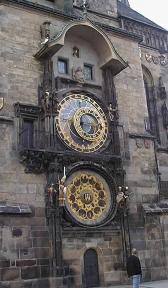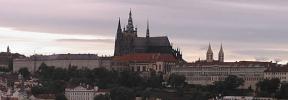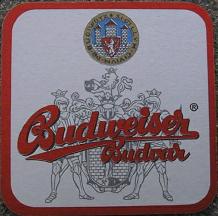
Praha (Prague)
June 7th - June 9th, 1999

Berlin was as far north as we're going on this trip (at least until we hit Japan), so we caught a train to a city that was on our maybe-visit list: Praha. We were glad we did. Praha proved to be one of the prettiest cities we've seen in Europe and very inexpensive. And the crowds are gone this year, scared away by the war in Kosovo. We only stayed three days and in hindsight we were sorry we didn't stay longer.
Many of the grandest sights are within a short walk of downtown. We stayed on the western side of the Vltava River, so to reach the main square we always walked across the Karlüv most (Charles Bridge). Finished in the 15th century, the bridge is decorated with dozens of statues depicting characters of religious and historical import (below on left and center). Built by Peter Parlér, the great architect of Praha medieval times (his image is on his grave's coverstone to the right), it is anchored by two fortified town gates and was essential in the defense of the city.
|
|
|
Once across the bridge, you enter an amazingly well preserved city. It takes little to imagine how one would feel to walk the streets of Praha centuries ago. The buildings have their own distinct Czech style, much different from what we've seen in western Europe. On the bottom left is a view that might have greeted Einstein during his first stint as a professor. Oddly enough, as we walked around we saw an inordinate number of Scotsmen wearing kilts. Turns out that a World Cup Soccer match between the Czech Republic and Scotland took place during our stay, and thousands of Scots were here to support the team. Made it all the more surreal.
|
|
Oh, how did they do? They got their kilted butts kicked, 3 to 1.
Holouhr
On the side of the town hall in a corner of the main square is this magnificent glockenspiel that was first built in the 15 century. Last updated in the 17th century, it is capable of displaying the date as well as the time and also shows the current constellations of both the Sun and the Moon. On the turn of the hour, it plays a lovely tune as the apostles parade by and a skeleton rings the bell of death.

Saint Vitus Cathedral
Like most old European cites, Praha had it's start as a fortress on defensible high ground. That original complex still remains, including the original 10th century town church. Updated by the Hapsburgs during the Austian-Hungarian era, most of the buildings are in the same condition as they were in the 16th and 17th centuries-- quite unusual, as royalty tends to demand the latest and greatest and even the oldest castles typically sport decor from the 19th and 20th centuries. It was here in one of the old rented cottages built into the former town wall that Kafka lived during his time in Praha during World War I.
 |
|
|
|
Inside the grand cathedral on the grounds, Saint Vitus, were hundreds of icons and artifacts. The most gaudy is the funeral casket of Stríbrny Náhrobek, who ruled here in the 14th century. Made of silver, it resembles a grand gravy boat more than anything else. Bottom right is a rather happy angel having his way with some poor devil.
National Museum
Sometimes the building is the show. Such is the case with the National Museum. Focusing on science and Czech pre-history, the collection isn't much by American standards, but the building itself is grand. Weekly recitals are held in the main atrium (top left) and may be a better way to see the museum.
|
|
|
|
There was an extensive section on Anthropology that tracked the history of humans in this portion of the world (top right, bottom left). No jokes about Jim being on the wrong end of the line up, now. Finally, a simply wonderful temporary exhibit on the history of the piano in Praha showed the craftsmanship for which Czechs are known for. Our favorite was the piano that one held like a modern guitar from the 18th century.
Sometimes you get lucky. While perusing books in the English language section of a bookstore Kathy came upon a book of the Microbreweries of Praha. All but one had been founded since Communism ended in Czechoslovakia, so we checked the old one out. Turns out that we went to the oldest brewery in Praha on its' 500th anniversary. U Flekû was having a three day bash to celebrate it's founding.
It's a big place that can seat 1200 people and had a four piece German Oompah band playing Bavarian drinking music. It wasn't packed, but the anniversary dinner and beer specials made for a nice afternoon.
|
|
|
|
We even took a private tour (we were the very last tourists that day) in German. U Flekû makes the last beer in the Czech Republic that uses air-cooling in it's brewing process. Normally you use refrigeration or ice to reduce the temperature of the cooked beer, but like Anchor Steam U Flekû uses big flat tubs (bottom right). They're a one beer shop and it's dark, so forget about ordering the Hefeweisen. It's a good beer and the cinnamon shots sure do liven up the evening.
- U Flekû
- Kremencova 11
- 10 00 Praha 1
- Tel: 02/29 32 45
- Fax: 02/29 68 79

While we didn't make the pilgrimmage to the little Czech town of Budweis, we did have plenty of the beer brewed there. The Czech Budweiser shares nothing except it's name with the American beer, and is touted as one of the best beers in the world. It is very good for a pilsner, but you likely will never find it in America. Anheiser/Busch and the Budvar brewery have an agreement that limits each others' distribution, and you can only find the good Budweiser in parts of Germany, Austria and the Czech Republic (and perhaps farther east -- we wouldn't know).
Interestingly enough, the American Budweiser is actually the older beer. Apparently, old Anheiser himself made a visit to Budweis back in the 19th century and was so impressed with the brewing techniques there he took the town name as the name for his beer. A few years later, the Budvar brewery opened and took the same name.
In general, we found Czech beer pretty good. About what you would expect for the land that invented beer.